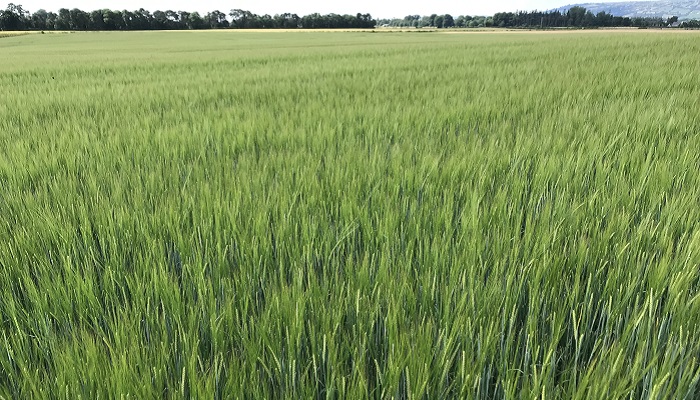22 June 2023
Developing better tools for the forecasting and control of BYDV

The large area of work being completed by Teagasc on Barley Yellow Dwarf Virus (BYDV) was displayed to those who attended the Crops and Cover Crop Cultivations Open Day in Teagasc Oak Park on Wednesday, June 21st.
Dr. Louise McNamara, a Teagasc Researcher Officer in Entomology, explained: “BYDV is a serious virus of cereal crops and it is spread by cereal aphids. Controlling BYDV is quite challenging for a number of reasons. We have lost pesticides that were available for their control, including neonicotinoids and Transform. The chemistry left – pyrethroids – there is insecticide resistance that the cereal aphids develop to it and climate change is a big issue because aphids reproduce faster in warmer weather.
“Our job is to look at different ways of controlling the virus. To do that we can’t just look at the aphid, the virus and the plants – we need to look at all three and how they interact within the system. By looking at all three, we are able to develop better tools for forecasting pressure and controlling the virus.”
For the plant, factors such as: season; planting time – spring versus autumn; cultivar susceptibility, tolerance or resistance; and planting date all have a massive effect on BYDV. In addition, the species of aphid – of which 25 spread Yellow Dwarf Virus (YDV) – how effectively they vector the virus and if they are resistant to pyrethroids all need to be understood. As there are 11 strains of BYDV, knowing what viruses are present, if it’s a single or co-infection, and the impact these single virus strains or co-infections have on yield is also important.
In the below video, Louise gives an overview of the BYDV research being undertaken in Oak Park:
What Yellow Dwarf Viruses do we find in Ireland?
Stephen Byrne, a Research Officer also based in Teagasc Oak Park, provided an overview of research which aimed to develop improved methods of testing for Yellow Dwarf Virus (YDV). Up until recently, he explained, much of the knowledge on YDV infection was based on serological or antigen type tests, which only cover a limited range of Yellow Dwarf Viruses.
“In order to generate the information that we need to develop better tests, we carried out a survey of symptomatic spring and winter barley crops across Ireland in 2021 and 2022. We simply sequenced the genetic material of the symptomatic plant tissue to uncover the viruses that were infecting the plants.
“We found the BYDV-MAV was by far the most abundant species of Yellow Dwarf Virus in Irish spring and winter barley crops. This is typically spread by the English Grain Aphid and it is generally regarded as having milder symptoms in comparison to some of the other Yellow Dwarf Viruses.
“We did also identify BYDV-PAS and BYDV-PAV in a proportion of our crops, but these were always as co-infections with BYDV-MAV. In these crops, BYDV-MAV was always the most prevalent. BYDV-PAS and BYDV-PAV are typically spread by the bird cherry aphid. This was the first report of BYDV-PAS in Ireland and it is generally considered as being a more severe variant of BYDV. We did identify a single incidence of Cereal Yellow Dwarf Virus and that was the CYDV-RPS species, which is considered a more severe variant of CYDV-RPV.
“Basically, with all this information, we have been able to improve our testing. The results from the survey have enabled us to design improved tools for managing Yellow Dwarf Virus in crops and aphids and these new tests are now being used in our surveillance programmes,” he explained.
Aphid resistance and improving surveillance
Maximilian Schughart, a PhD student in Entomology, highlighted research work examining knockdown resistance (KDR) in aphids, with samples taken from trial sites throughout Ireland. This research highlighted that the levels of resistance vary between years. Commenting on initial results from two years of a three-year study, he said: “In 2021, we found very low levels of resistance and in 2022, we found higher levels of resistance. The resistance though, is only a partial resistance.”
The second part of his PhD study is examining if KDR aphids can transmit BYDV more efficiently, with results showing that resistance does not improve virus transmission. No differences in BYDV-MAV were observed, while the level of BYDV-PAS transmission in KDR aphids was low.
Jack Perry, also completing a PhD in Entomology, discussed his work on improving aphid and BYDV surveillance. “There isn’t a robust threshold for when the level of aphids in the field leads to the virus and what I’m looking to improve is our management and our use of decision support tools.
“Our aim is to validate different monitoring tools and determine their suitability to be used as decision support tools for BYDV control.”
The first part of Jack’s project involves monitoring, with 23 growers placing yellow water traps 10m, 20m and 50m into their crops. The aphids collected in these traps are identified and tested for BYDV. A visual aphid search, leaf sampling and whole field BYDV assessments are also conducted for every field. Such monitoring processes could form part of further integrated pest management (IPM) practices for BYDV going forward.
